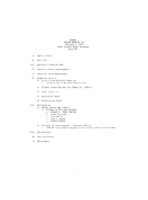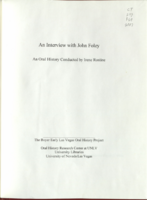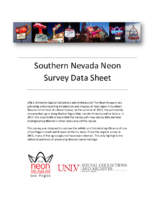Search the Special Collections and Archives Portal
Search Results

Andres Dominguez oral history interview: transcript
Date
Archival Collection
Description
Oral history interview with Andres Dominguez conducted by Marcela Rodriguez Campo, Laurents Bañuelos-Benitez, and Barbara Tabach on February 11, 2019 for the Latinx Voices of Southern Nevada Oral History Project. In this interview, Dominguez discusses his upbringing in Las Vegas, Nevada and growing up on the Eastside. He talks about the history of barbering in his family, and his path to becoming a barber. Dominguez describes the process of acquiring the barbershop at the El Cortez Hotel and Casino, and the significance of the location to his family. Lastly, Dominguez discusses his perspective on life, the importance of networking, and his decision in naming his shop Speakeasy Barbershop LV.
Text

José Luis Meléndrez oral history interview: transcript
Date
Archival Collection
Description
Oral history interview with José Luis Meléndrez conducted by Laurents Bañuelos-Benitez on November 20, 2018 for the Latinx Voices of Southern Nevada Oral History Project. In this interview, Meléndrez discusses his family background and early life in Baja California. He talks about his father's decision to migrate to the United States, and attending Catholic schools in California, Nevada, and Texas as the family moved around the country. Meléndrez recalls moving to Las Vegas, Nevada in 1990, enrolling at the University of Nevada, Las Vegas (UNLV), and his involvement with the Boy Scouts of America affiliated program, Learning for Life. Later, Meléndrez describes attending the University of Michigan, earning a master's degree in social work, and becoming executive director for the office of Community Partnerships in the UNLV School of Public Health. Lastly, Meléndrez discusses the future of the Las Vegas Latinx community, and becoming a founding member and chair for the Nevada Minority Health and Equity Coalition.
Text

Meeting minutes for Consolidated Student Senate, University of Nevada, Las Vegas, February 06, 1979
Date
Archival Collection
Description
Text

Transcript of interview with Elbert Edwards by Ronald Johns, 1972
Date
Archival Collection
Description
On an unspecified date in 1972, Ronald Johns interviewed Elbert Edwards (born 1907 in Panaca, Nevada) about his life in Southern Nevada. Edwards first talks about his family’s move to Panaca, Nevada in 1864 and talks briefly about his work in Las Vegas public schools during the Great Depression. The two also discuss the Boulder Dam, Edwards’ involvement in politics, and mining in Nevada. He also talks about the cost to build a home in Las Vegas in 1936, the development of Boulder City, and the way of life in the small town of Panaca. The interview then moves on to the topics of the early territorial boundaries of Nevada and Utah, the atomic testing at the Nevada Test Site, and early water sources in Southern Nevada.
Text

Transcript of interview with John Foley by Irene Rostine, May 11, 2011
Date
Archival Collection
Description
Text

Lucky Cuss Neon Survey document, September 14, 2017
Date
Archival Collection
Description
Site address: 3305 Fremont St
Sign owner: D B N G LLC
Sign details: This property was originally the Panorama Motel, which opened in the 1950's. However, the signage later changed to fit the Lucky Cuss Motel. It was removed from the property in 2008. In 2012, the old sign was restored by the Neon Museum and placed on Las Vegas Boulevard. The replacement sign is still at the property.
Sign condition: 5 - appears to be well maintained
Sign form: Roadside pole
Sign-specific description: The sign at the property is a rectangular cabinet, with the edges at the top rounded off. The background of the cabinet is red, and the outline is blue. The words "Lucky Cuss" are white in a stylized front, and the word "Motel" in larger, block white lettering. On the side of the cabinet is the address 3305.
Sign - type of display: Neon
Sign - media: Steel
Sign environment: Property is on Fremont St, near a car dealership and other motels
Sign - date of installation: c. 2008
Sign - thematic influences: The sign does keep some of the original elements of the first sign, the 1950s era stylized font and simple outlines of neon.
Sign - artistic significance: The sign, although new, does throwback to the original's 1950s creation date.
Survey - research locations: Assessor's website, roadarch.com
Surveyor: Lauren Vaccaro
Survey - date completed: 2017-09-14
Sign keywords: Neon; Steel; Pole sign; Roadside
Text
Marguerite and Jack Wagner Photograph Collection
Identifier
Abstract
The Marguerite and Jack Wagner Photograph Collection, approximately 1949 to 1970, consists of black-and-white photographic prints and negatives depicting the Wagner Motor Company automobile dealership in Las Vegas, Nevada. Included are images of Wagner posing with customers in front of automobiles.
Archival Collection
May Bradford Photograph Collection
Identifier
Abstract
The May Bradford Photograph Collection (1870-1976) consists primarily of black-and-white photographs depicting Bradford's life including her time in Tonopah, Nevada. The collection also includes images of her early life and her family in Missouri. Other photographs document her son as an infant, as well as the family's time spent living abroad.
Archival Collection
